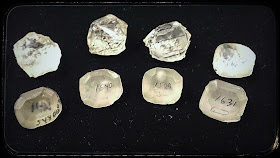Suzette Gomes, CEO of Cora International, with the Blue Moon diamond on exhibit at the Museum of Natural History of Los Angeles County. Photo by E. Chamorro for NHMLA.
Did you check the Blue Moon diamond on display at Natural History Museum of Los Angeles County? You will see that we added the resin models of the different steps of the cutting process. Thanks to information provided by Cora International and the master cutter, here is the description our volunteer Brittany gathered. It is interesting to see the process of having an extremely valuable rough blue diamond and making a decision on how to cut it to yield the best color, clarity and shape. Enjoy!
The added resin models on display at the Natural History Museum of Los Angeles County. Photo by E. Gaillou for NHMLA.
The Blue Moon Diamond is one of the rarest diamonds in the world. Therefore the cutting process is a rather meticulous procedure. The rough diamond must first be placed into the hands of a master cutter. Most master cutters have been working in the trade for decades. The master cutter will examine the natural growth features of the rough diamond. From there, many models of the stone will be made. Creating models at every stage is a very important and significant part of the cutting process. These models give a blueprint to follow in creating this beautiful and extremely rare gem. Each model will be marked to determine the best shape and size of the stone. Once the model is marked, the cutter will begin to form facets into the model on the cutting wheel.
Zoom in on the models. The numbers you read represent the carat weight of some steps of the cutting process.Photo by E. Gaillou for NHMLA.
The Blue Moon diamond at 22.79 carats. © Cora International.
The Blue Moon diamond on the cutting wheel. © Cora International.
The Blue Moon diamond at 19.30 carats. © Cora International.
The Blue Moon diamond at 19.30 carats. © Cora International.
Once 14.21cts were reached, it was known that the gem had now achieved the “Internally Flawless” clarity grade. After achieving the final result on the model, the rough diamond was then able to be faceted on the wheel and polished into one of the rarest and most exquisite diamonds in the world.
The Blue Moon diamond at 14.21 carats. One already can see the beauty of the stone! © Cora International.










you pictures are so cool! what kind of camera do you use and where to you get your film developed?
ReplyDelete